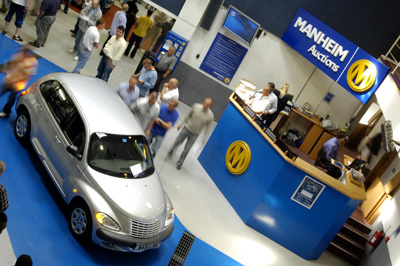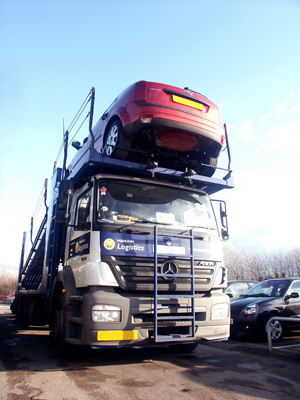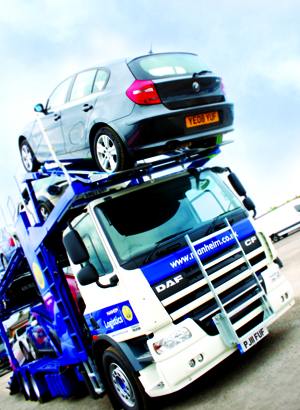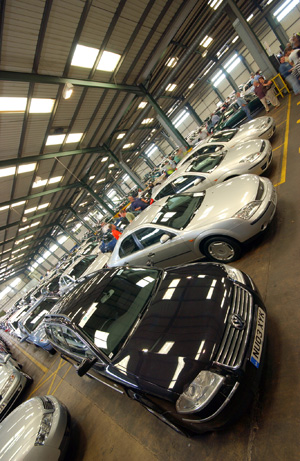Auction houses sell millions of cars around the world both online and at centres, and they need specific and complex logistics solutions to meet their customers' changing needs.

Solutions are also changing in line with evolutions in the auction market. The rise of online auctions, for example, means that a buyer from one end of a country can bid on a vehicle hundreds of miles away – or even across borders. Like many online retail experiences, customers in these cases will expect a transport service to deliver the vehicle, perhaps at various price points depending on the speed of delivery.
The numbers involved in used car and auctions are staggering. The UK arm of the Manheim Group, a global auction and online vehicle trading platform, sells around 500,000 used cars and vans every year in the country to trade buyers and the general public – a figure that on its own is equal to about 25% of the UK’s annual new vehicle market. It’s a business that increasingly needs to run more efficient logistics to keep costs at a minimum, as well as needing more sophisticated logistics services from providers to keep up with customer expectations.
Different transport for different customers
According to Darren Simpson, general manager for transport and logistics at the UK’s Manheim Remarketing, there is no single process for moving vehicles into the company's auctions. Instead, he explains that systems vary depending on customer requirements. Manheim works for a number of different customer groups, including national fleet and leasing companies, dealer networks, local dealers, manufacturers, collection and repossession agents and private sellers. In Simpson's view, the challenge is that all of the customers have different ways of operating, even within the same customer group.
"Vehicles may be delivered to the auction centre or we may arrange collection. If we collect, this can be managed via our own transporters, our approved subcontracted transporters, our own platers or our approved subcontracted platers," he says.
According to Simpson, choosing the methods of transport is determined by mileage from the auction, the number of vehicles to be collected, the type of vehicle, whether specialist equipment is needed (a heavy goods vehicles, for example), and the resource levels at the destination auction centre.
 Depending on the size of the auction centre and the locality of the dealer, large national buyers may provide their own transporters
Depending on the size of the auction centre and the locality of the dealer, large national buyers may provide their own transportersCurrently, Simpson says that auction centres manage their own customer requirements, which means that resources can be allocated tospecific needs. Centres with more local dealers tend to have their own transporters, while sites with national fleet customers tend to use a large network of drivers to collect individual vehicles from around the country. If the customer is a car manufacturer, it will usually arrange its own transport services.
When it comes to customer expectations around deliveries, Simpson adds that approaches also differ – local or large national buyers who purchase a number of vehicles at any one auction will usually have their own transporters or subcontracted arrangements in place, for example.
"Private buyers tend to drive the car away. At a closed manufacturer auction, there is often a deal in place to deliver vehicles within 48 hours," he says.
Bespoke operations
Meanwhile, CD Auction Group, a British online remarketing company, uses its own online management tool, VendorNet, for managing inbound vehicle logistics. Managing director Roger Woodward explains that vendors post their requirements to VendorNet and the company manages the process using conventional vehicle logistics operators to collect cargo.
"The trick is to minimise vehicle movements and offer a cost-effective solution as part of an appropriate remarketing package. That could also include vehicle refurbishment and short-term storage," he says.
The company offers a range of solutions for outbound vehicles depending on the buyer, which Woodward says could be a trade-plated driver for an individual car or a small transporter for a batch of vehicles. "We have automated processes in place for regular buyers," he adds.
For Manheim’s Simpson, the key difference between moving new vehicles and used is that new car movements tend to be full truckloads, which are usually collected from manufacturing sites and delivered directly to dealers or to docks for onward shipping. These loads can be predicted in advance, with contractors tending to sign up for long-term arrangements to manage movements.
"From a practical point of view, the number of transport companies in the [UK] market place is reducing, the vehicles are changing shape and transporter drivers are scarce." - Darren Simpson, Manheim Remarketing (UK)
"The auction centres rarely get full-load work, as customers want to sell what they have available,” he says. “This usually happens in volumes of one to five vehicles at a time, except the large car supermarkets, which are more likely to operate in bulk.”
Simpson adds that a dealer looking to move unwanted exchanges may deliver to auction or request a local collection, while national fleet and leasing companies tend to use drivers to collect from contract hire and leasing customers and deliver direct into the auction network.
Woodward points out that the same haulage operators might be used between new and used vehicles, however the used-car process is more “bespoke”, often moving small batches of cars to repeat addresses, which makes efficient processes important. "With used cars you are not looking to carry stock, both vendors and buyers are wanting to reduce downtime in order to get vehicles on sale as quickly as possible and recover their asset cost," he says.

For Simpson, Manheim’s main challenge in managing the logistics and shipping of used vehicles is the need to balance the expectations of the customer with the realities of the supply chain. "Logistics is not the core business of an auction centre but is an integral part of the auction supply chain," he says.
He believes it should be viewed as a service that adds value to buyer and vendor. "From a practical point of view, the number of transport companies in the [UK] market place is reducing, the vehicles are changing shape and transporter drivers are scarce,” he says. “Indeed, it can be difficult to find an HGV [heavy good vehicle] driver who is also prepared to reverse a car onto the top deck of a transporter."
Mixed loads can also prove challenging, he adds. "The utilisation of a transporter is less efficient moving LCVs [light commercial vehicles] or 4x4 vehicles, than it might be with small family cars,” he says.
CD Auction Group’s Woodward says the difficult for logistics is around reducing vehicle movements, managing short-term storage and presenting vehicles for sale in the right condition to the right buyers. In his view, online auctions have an advantage in this respect, because they can present cars to a national, or even international audience.
"Vendors can build up a national following for their vehicles without having to dilute stock by splitting it around the country, and they only have to move it to one central location,” he says.
While most auctions are country specific, or even more local, used cars are also shipped around the world for auction or resale. According to Richard Cox, CEO at Kar-Tainer International, which manages used car exports in containers, cost is the biggest factor in shipping used vehicles.
"Markets are looking for cheaper alternatives, so shipping processes are not so important, as quality is not the issue it is for new car shipments," he says.
Nevertheless, the process for shipping used vehicles, especially by ro-ro, is just as complicated – if not more so – than moving new cars, according to Jason Winter, general manager of auto/ro-ro at Ports America, a US-based vehicle processor and terminal operator. Port America handles approximately 7,500 used cars at each one of its facilities on an average day, which are destined for several different ports on several different carriers.

Winter explains that there are many steps involved in ensuring that used cars are exported according to the right processes and regulations. The company carries out extensive checks on vehicles, and stages them according to loading. It receives a plan from the shipping line detailing the correct decks to load each vehicle and commodity type on the vessel, along with deck heights and maximum weights of the vessel’s ramps.
“If everything matches, we proceed with sending the labour out to the field,” says Winter. “At this time the mechanics and processors have a few lines of cargo started and ready for the drivers to take the cars to the vessel where they are scanned.”
Upon completion of vessel loading, the scan-guns are reconciled against the original load list to ensure all the correct cargo has been loaded. This list is then sent to the line for creation of its manifest.
Safety first for second-hand cars
According to Winter, along with maintaining quality and efficiency, ensuring safety is important when handling used cargo. He points out that, while defective vehicles are rare when handling factory-new cars, used cars are less reliable and require more checks. While on the vessel, a unit may start leaking fluids, such as transmission fluid, and cause a hazard for personnel working on the deck and for the remaining units that may drive through that leaked fluid. With up to 100 people working aboard a ro-ro ship, Winters says there is no room for complacency.
"Driving on a metal deck can be slippery on its own, but it becomes even more slippery when oil or transmission fluid is present on the decks, especially when making the tight turns necessary to navigate on a ro-ro vessel," says Winter.
Winter also highlights that loading export cargo can be extremely fast paced and that a great amount of planning goes into loading a vessel with used cargo.
"We may be loading cargo for several different discharge ports,” he says. “The decks may be different heights on the vessel so cars and SUVs cannot be mixed. We may not be the last port of loading so a large amount of planning must be spent on ensuring the next ports can load their cargo without having to move our cargo, while ensuring our cargo still can be discharged without moving other cargo at each importing port.”
Winter explains that there are several different classes of labourers present on a vessel, with different foremen for each group, which need to work in coordination to keep the used-car operations moving. There are also mechanics and processors to start cargo in the field, as well as a long list of other specialist staff, including drivers, people to push non-running cars on to the vessel, lashers to secure cargo, parkers, signal personnel, checkers that note cargo’s serial number and clerks to note what cargo is loaded where on each deck of the vessel.
Looking ahead, Woodward believes that one of the trends for auction house and used-car logistics over the next few years will be the development of online management tools.
"We already offer pool fleet management, which links a vendors’ inventory directly into the remarketing process, saving time and money for major contract hire and leasing companies," he says.
 With increased volume comes progress: more auction vehicles are being moved by a 'drop and swap' method, where trailers are loaded without a tractor unit
With increased volume comes progress: more auction vehicles are being moved by a 'drop and swap' method, where trailers are loaded without a tractor unitAs volumes grow, Simpson also expects that there will be new product development. This has already led to the introduction of trailers better suited to the ‘drop and swap’ scenario, whereby vehicles can be loaded and unloaded without the need for an in situ tractor unit.
"This may help bring down the cost of owning equipment and make it easier for buyers and vendors to more closely manage their movements. However, the Euro VI legislation [for emissions] will have an impact on transporter costs," he says.
Manheim is also starting to look into new transport systems and scheduling software to streamline operations. In Simpson's view, it is likely that used-car movements will become closer in model to the pallet network or parcel approach.
"Service will be paramount and time-specific deliveries may well be introduced,” he says. “We expect to see an increase in the use of mobile handheld technology to make the inspection process paperless.”
Finally, the growth in online auctions has made it far easier for buyers to source the right stock from anywhere in the country. However, in reality this means that vehicles may have to be transported far greater distances in the most efficient way possible. “It’s a potential headache for transport schedulers!" says Simpsons. But it is clearly an opportunity for logistics providers.

























![Global[1]](https://d3n5uof8vony13.cloudfront.net/Pictures/web/a/d/s/global1_726550.svgz)









